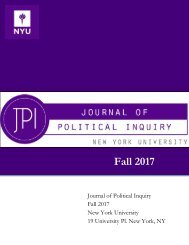Fall2016_Final
You also want an ePaper? Increase the reach of your titles
YUMPU automatically turns print PDFs into web optimized ePapers that Google loves.
Scott D. Sagan suggests that introducing civilian nuclear technicians and personnel into the military<br />
establishment may help increase the voice of the civilian government. 55 Sagan also points out that<br />
organizing public, inclusive debates on the contribution of nuclear arsenals to Pakistan’s national<br />
security could be another way for civilian leadership to influence the military’s nuclear policy. 56 In<br />
short, increasing civilian control will likely encourage Pakistan to be more peaceable in its relations<br />
with India.<br />
4) Trade and Economic Incentives – Just as MERCOSUR strengthened Argentine and<br />
Brazilian interest in nuclear cooperation by increasing interdependence and the cost of nuclear<br />
competition, improving trade between India and Pakistan would likely do the same. A nuclear<br />
cooperation project for India and Pakistan ought to integrate trade cooperation so as to raise incentive<br />
for participation. The international community should take advantage of the fact that there is<br />
enormous room for improvement in Indian-Pakistani bilateral trade. Taneja et al wrote that “[t]he<br />
potential bilateral trade between India and Pakistan has been estimated to be around US$20 billion,<br />
compared to the current trade volume of USD $2.6 billion.” 57 This large gap reveals that there is ample<br />
room to remove trade barriers. What’s more, the trade along Jammu and Kashmir’s Line of Control<br />
remains highly restrictive. In recognizing the huge benefit of free trade across the Line of Control,<br />
Sajad Padder argues that liberalization would enable the local economy to flourish and could lead to<br />
India-Pakistan reconciliation over this disputed territory. 58 A peaceful Kashmir could, in turn, increase<br />
India and Pakistan’s willingness to resolve their nuclear dispute. If bilateral trade had been operating<br />
at full potential, previous nuclear and military escalations would likely have been too costly for both<br />
countries.<br />
CONCLUSION<br />
The end of suspicious nuclear rivalry between Argentina and Brazil and their full participation<br />
in bilateral, regional and global nonproliferation regimes represents one of the most significant<br />
contributions to the international community’s nuclear disarmament effort. After two and a half<br />
decades of competition to attain nuclear superiority, the two governments, through their<br />
unprecedented bilateral initiatives, managed to gradually place their nuclear relationship on a<br />
cooperative footing. This cooperation climaxed with the two states’ accession to the NPT in the midto<br />
late 1990s. The bilateral nuclear inspection agency, the advent of civilian government and civilian<br />
control over nuclear policy, the desire to secure economic benefits of denuclearization, and the<br />
formation of a regional trade bloc were largely responsible for the positive change. The Argentine-<br />
Brazilian nuclear cooperation model underlines the fact that alternative paths to the NPT can also lead<br />
to an outcome supportive of nonproliferation.<br />
This essay advocates using the lessons learned from Latin America to create policy<br />
recommendations for addressing South Asia’s nuclear arms race. Because of the differences in<br />
historical and political circumstances between the two regions, this research acknowledges that the<br />
factors that led to positive engagement in nonproliferation in one region would yield a much less<br />
effective result in the other. Nevertheless, the policy-recommendations put forward here could be<br />
invaluable for reducing nuclear conflict in South Asia. Of particular interest to policymakers is the role<br />
of bilateral confidence-building measures, such as the ABACC, which has taught the world that the<br />
55<br />
Scott D. Sagan, “The Evolution of Pakistani and Indian Nuclear Doctrine,” in Inside Nuclear South Asia, ed. Scott D. Sagan (Stanford, CA: Stanford<br />
Security Studies, 2009), 254.<br />
56<br />
Ibid.<br />
57<br />
Nisha Taneja, Sanjib Pohit and Shravani Prakash, “Chapter 12 – The Way Forward,” in India-Pakistan Trade: Strengthening Economic Relations, ed. Nisha<br />
Taneja and Sanjib Pohit (India: Springer India, 2015), 337.<br />
58<br />
Sajad Padder, “Cross-LoC Trade: Peace and Process,” Social Sciences Review of Pakistan 1, no. 2 (Winter 2014): 1 and 13.<br />
Journal of Political Inquiry | Fall 2016 | 12
















